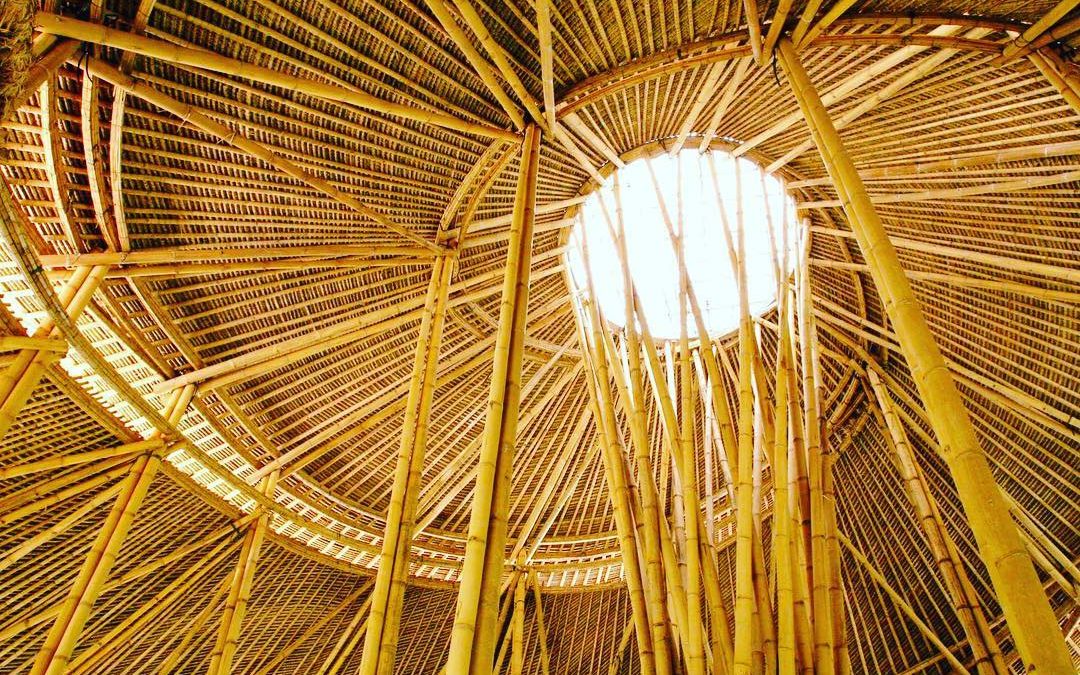-
Bamboo has been called the ‘green steel’ of 21st century Asian architecture. Used across the continent for thousands of years, a new generation of international architects and engineers are discovering its potential and spreading the word to all corners of the globe. As farmers in the U.S.A find solutions to growing bamboo in temperate climates and architects innovate new designs and methods of building, it seems plausible that European cities could see more bamboo construction in the future. This has already started happening in some countries: in 2014 a car park in Amsterdam was clad in bamboo (you can take a look at the Slotervaart medical center). Connecting sustainability with beauty, tradition with innovation and theory with practice, the pioneers at Bamboo U are contributing to a shift towards greener building practices.
What is different about designing with Bamboo than with conventional building materials?
On our one-day, three-day and eleven-day courses, people are taught how designing bamboo buildings takes an entirely different approach than when building with conventional construction materials such as concrete, wood or steel. Bamboo architecture isn’t taught at any tertiary institution; you can’t receive a qualification in it. Instead, it has taken a group of motivated, pioneering individuals, each with strong reputations in their field, to cultivate bamboo construction to the level it’s at today. Unrestricted by established institutions and their curriculum, this community of innovators experiments with construction, constantly developing new techniques and designs.
The natural properties of bamboo allow you to build unique structures, each with their own character. However, due to its organic form, bamboo hasn’t been officially recognized as a standardized material in countries where there are strict building standards. In Europe, for example, buildings made entirely from bamboo are extremely hard to get authorized. In countries and regions without such rigid regulations, like here in Bali, there is more room for experimentation.
That being said, though, there are certain processes that allow for standardization. Through rigorous factory procedures, you can manufacture cross-laminate beams, columns, flooring and partitions that have been given a quality standard and can be shipped internationally. It is only when building with bamboo in its organic form that issues arise with regulations.
Does Bamboo U use traditional Balinese architecture and construction methods in its designs?
We use a lot. There is a primary joining technique called the ‘fish mouth’ that local Balinese carpenters have used for centuries and we use in our builds. Most of our carpenters come from a community in Bali that has been dubbed the ‘bamboo village’. Their methods have been passed down through generations and the richness of their shared knowledge is truly inspiring. The architects, engineers and designers who come from all over the world learn a lot from the local carpenter’s traditional methods, and vice versa. The creative exchange between the community of people who work with us is very encouraging – everyone is always learning about bamboo and the potential of the material.
How can people in Europe incorporate bamboo into an everyday build?
To build structures like ours, which use bamboo in its organic form, you would have to knock on some pretty heavy doors to get the tick of approval. The strict building regulations in Europe also require the bamboo to be highly processed and shaped, which is expensive. As it stands, building in Europe with raw Bamboo is not widely feasible as the building code prevents us form using it on the scale you see in Bali, especially IBUKU.
It’s not all hopeless, though. Although it can’t be used in the same way as here in Bali, bamboo can still be used to substitute non-renewable materials. Whether used on a small or large scale, there are lots of ways to integrate bamboo into any design or construction project. You see a lot of countries in Europe incorporating bamboo into different aspects of product design; for example, furniture, cutlery, lighting installations, flooring and partitions. Exploring the possibilities of bamboo use is vital at this stage. Even small-scale bamboo products contribute to showcasing the potential of bamboo as a versatile, beautiful material.
How does it feel to live in a house made from Bamboo?
When I first arrived at Bamboo U as a student, I was given the key to a beautiful bamboo bunk house. It was very simple, literally a bamboo box with one window and one door, but so beautiful. I experienced an earthquake there in September last year. I woke at 5 am to feel the whole house shaking. At first, I didn’t realise what was happening – it was very disorientating. I looked at the walls and thought to myself: “is this building going to fall on me, and if it does, will I survive?” It was a very sobering moment. I recalled all I had learnt about the flexibility and strength of bamboo and decided that it would probably hold. If it didn’t, bamboo is a lightweight material which further increases likelihood of survival. My friends were staying in a concrete villa nearby and really panicked during the earthquake. They ran out of their house and into an open space because they were genuinely terrified for their lives. Unlike concrete, bamboo can withstand significant trauma from natural disasters, which makes it valuable in countries like Bali which are regularly affected by earthquakes.
On our courses, we take students to IBUKU‘s Green Village to see the incredible homes there. They are works of art. I have stayed in one of these homes for a few nights. It’s hard to believe that you are living in a house made from grass- it is inspiring! You also quickly find that your body adjusts to a more natural rhythm. You totally zone out of normal life and enjoy being in nature. I’ve had the best nights sleep of my life in bamboo buildings.
Can you tell me about the positive environmental effects of bamboo?
I learnt recently that Bamboo is the quickest plant species in the world to grow a canopy. Bamboo grows to its full height within 6-9 months and can be sustainably harvested after propagation within 7-10 years. This rapid growth rate means that it sequestrates a lot of carbon from the atmosphere, which is of course beneficial for combating climate change.
It is a very exciting time for bamboo; there are some amazing innovators advocating its positive environmental effects. Arief Rabik is one of those. Following in the footsteps of his mother, Linda Garland (founder of the Environmental Bamboo Foundation), Rabik is a bamboo specialist and environmentalist with over 15 years of experience in bamboo forest management. A true pioneer, Rabik travels the world preaching the good news of bamboo to anyone who will listen. He has a program called 1000 bamboo villages, an initiative to replenish around 2 billion hectares of degraded land through bamboo forestry.
To increase bamboo cultivation and to witness all the positive environmental effects it can bring about, there needs to be a market for it. This is generated through architecture and product design; if people can see its elegance and beauty, bamboo will become a desirable material and farmers will respond to the increased demand. Of course this needs to be addressed with caution. While it does have a positive environmental effect, as soon as you start growing anything on a massive scale without any regard for the fragile ecosystem, the environment becomes unbalanced and things start to go wrong. We’ve seen that with the palm oil plantations throughout Indonesia. Bamboo innovators are very aware that it needs to grow in harmony with the rest of the ecosystem and they work hard to establish careful and sustainable farming methods.
What can people expect from your workshops?
- 1 day Introduction to Bamboo
- 3 day Bamboo Design and Construction
- 11 day Intensive Bamboo Design and Construction
Our courses are for people motivated to make a change and learn something new. Each course we offer is different. On the 11 day course, for instance, we spend time teaching bamboo forestry, preservation, propagation and harvesting techniques. There’s also a strong focus on carpentry, joining techniques and model making. Bamboo designers and architects from IBUKU help to facilitate the course. We give the students tours of the bamboo factory, going into detail about the preservation and treatment of bamboo.
The second half of the course is putting all of that theoretical knowledge into practice. Taking a design onsite and building a 1:1 scale building made entirely from bamboo, this gives students a hands-on experience of bamboo construction. In the past, we’ve built an office, an anti-clastic (architectural technique using curves) meditation room and a bamboo storage facility. In order to constantly come up with new ideas, learning experiences and techniques, we endeavor not to replicate techniques that are used in other builds. At the moment, we are building our biggest structure to date; the bamboo U kitchen. It is 11 metres high and is a ‘splayed reciprocal tower’ design. We have used reciprocal towers in the past as they allow us to create structures entirely from bamboo- they are built in a helix pattern and are self-sustaining and don’t require supporting materials. Reciprocal towers have never been built to the scale we are building.
What is the future for bamboo U?
We aim to continue with our research and development, implementing new ideas in our designs and educating people through our courses. We will continue to nurture an open culture where creative dialogue is encouraged, and new voices are heard. We are constantly learning about the potential of bamboo for worldwide use, watch this space!
Source: https://www.dedi.co/blog/entries/2019/06/14/pioneering-design-and-construction-material-future


Recent Comments